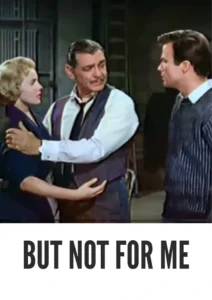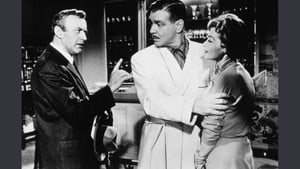Video Sources 0 Views
- Watch trailer
- But Not for Me 1959 Colorized


Synopsis
Table of Contents
Toggle
Step into the world of Broadway with But Not for Me, a delightful romantic comedy from 1959, now beautifully colorized for a viewing experience like never before. This film, starring the iconic Clark Gable, alongside Carroll Baker and Lilli Palmer, delivers a humorous and heartwarming story of love, age, and second chances in the dazzling world of theater. Perfect for fans of classic film enthusiasts and those seeking a lighthearted escape, this HD download brings a timeless piece of cinematic history to your screen.
But Not for Me follows the story of Russell “Russ” Ward (Clark Gable), a seasoned Broadway producer contemplating retirement. Feeling his age and struggling with a new play, Russ finds himself revitalized when his young, adoring secretary, Ellie Brown (Carroll Baker), proposes marriage.
Inspired, Russ decides to incorporate this scenario into his new play, casting Ellie in the lead role. As they work together, the lines between fiction and reality blur, leading to a series of humorous and heartfelt situations. Russ’s ex-wife, Kathryn Ward (Lilli Palmer), adds another layer of complexity to the story, as she secretly supports Russ’s endeavors. The film explores themes of age, love, and the courage to take a second chance, all set against the backdrop of the vibrant Broadway scene. Ultimately, But Not for Me is a charming and entertaining film that celebrates the unpredictable nature of love.
The film features a stellar cast of actors who bring this romantic story to life:
-
Clark Gable as Russell “Russ” Ward
-
Carroll Baker as Ellie Brown / Borden
-
Lilli Palmer as Kathryn Ward
-
Lee J. Cobb as Jeremiah MacDonald
-
Barry Coe as Gordon Reynolds
But Not for Me falls into the genre of romantic comedy, with elements of satire and social commentary that are characteristic of films from this era. Its witty dialogue, charming performances, and lighthearted tone make it a delightful and engaging film.
Released in 1959, But Not for Me reflects the changing social dynamics of the late 1950s, particularly in its exploration of age differences in romantic relationships. The film was produced during a period when romantic comedies were a staple of Hollywood cinema, offering audiences an escape from the anxieties of the Cold War era. While But Not for Me may not be as widely known as some of the other romantic comedies of the time, it offers a valuable glimpse into the era’s social attitudes and cinematic conventions.
This colorized version of But Not for Me has been meticulously restored using modern digital techniques, enhancing the visual appeal while preserving the film’s original charm. The colorization process involved carefully analyzing the grayscale tones of the original black and white footage and assigning appropriate colors to each scene. This painstaking process brings new life to the characters and settings, making the story even more engaging for modern audiences. While opinions may vary on colorizing classic films, it introduces these films to a broader audience, ensuring their appreciation for future generations.
-
: Walter Lang
-
: Samson Raphaelson
-
: the play Accent on Youth by Samson Raphaelson
-
: Milton Krasner
-
: Robert L. Simpson
-
: Perlberg-Seaton Productions
-
: Paramount Pictures
-
: 1 hour 51 minutes
-
: MP4
-
: HD (1080p)
-
: Compatible with most devices, including smartphones, tablets, computers, and smart TVs.
But Not for Me (1959) is a delightful romantic comedy that showcases the talents of its stellar cast. Clark Gable delivers a charming performance as the aging Broadway producer, while Carroll Baker shines as the adoring young secretary. The film’s witty dialogue and lighthearted tone make it a timeless classic that continues to entertain audiences today. As a lesser-known gem from Hollywood’s golden age, But Not for Me offers a unique perspective on love, age, and the magic of Broadway.
-
: What is But Not for Me about?
-
A: But Not for Me is a romantic comedy about a Broadway producer who finds unexpected love with his young secretary.
-
-
: Is But Not for Me (1959) a well-known Clark Gable film?
-
A: While not as widely known as some of his other films, But Not for Me is a delightful romantic comedy that showcases Gable’s charm and talent.
-
-
: Is this version of But Not for Me colorized?
-
A: Yes, this version has been professionally colorized to enhance the viewing experience.
-
-
: What makes But Not for Me interesting for classic film fans?
-
A: But Not for Me offers a glimpse into the world of Broadway in the late 1950s, with witty dialogue, charming performances, and a heartwarming story.
-
-
: What is the download format?
-
A: The download format is MP4, which is compatible with most devices.
-
-
: What resolution is the download?
-
A: The resolution is HD (1080p), providing a high-quality viewing experience.
-
Watch But Not for Me Today!










